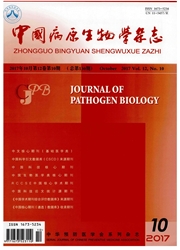

 中文摘要:
中文摘要:
目的分析螨变应原的聚类、所属的蛋白家族及其氨基酸序列组成特点。方法从国际免疫学会联合会变应原命名数据库获得螨类变应原氨基酸序列,采用生物信息学方法进行进化树构建、蛋白质家族和超家族分类、序列比对、二级结构分析和序列相似度分析。结果螨类变应原第1~24组分在系统进化树中按照功能策类成7大簇,归属于Trypsin等16个蛋白质家族和Esetdomains等13个蛋白质超家族。通过序列比对,获得螨类变应原第1、2组分的一致性氨基酸和独有氯基酸信息及第1、2组分亚型间氨基酸置换信息。螨类变应原第1、2组分的二线结构基奉都由α-螺旋、延伸主链和无规卷曲构成,但TyrP2的二级结构不含α-螺旋。Derf1、Derp1和Eurm1序列相似度高(82.77%~84.50%),在进化树中也聚类在一起;Derf2、DerP2和Eurm2亦然(相似度分别为84.17%~85.15%)。结论螨类变应原第1-24组分归属于16个蛋白质家族和13个蛋白质超家族,并聚类为7个簇,每簇变应原都有其特定功能,可为新变应原的寻找和变态反应学的基础研究提供参考,并为重组变应原的研究提供新的方向。
 英文摘要:
英文摘要:
Objectives To identify clusters of mite allergens and the protein families to which those mite allergens be long and to determine the function of mite allergens. Methods Amino acid sequences of mite allergens were obtained from the International Union of Immunological Societies nomenclature database. Bioinformatic tools such as MEGA 5.05, DNAMAN 6.0, VECTOR NIT 11.0, and GOR 4.0 were used to identify mite allergens in groups 1-24. Results were used to predict and analyze evolutionary relationships, classify protein families and superfamilies, determine sequence a- lignment, and ascertain the secondary structure and sequence similarity of mite allergens in groups 1- 24. Results Mite allergens in groups 1-24 belonged to 16 protein families and 13 protein superfamilies, such as trypsin and the E set do- main superfanfily. In a phylogenetic tree, mite allergens were clustered into seven clusters on the basis of their function. Sequence alignment provided information on identical and unique amino acid residues in mite allergens, and it also provided information on residue substitutions within subtypes of Group 1 and Group 2 mite allergens. The secondary structure of Group 1 and Group 2 mite allergens consisted of an α-helix, extended strand, and random coil, but Tyr p 2 had no α- he lix. Der f 1, Der pl , and Eur m 1 had a high sequence similarity between 82.77%- 84. 50% and were clustered together in the phylogenetic tree. Der f 2, Der p2, and Eur m 2 had a high sequence similarity between 84. 17%--85. 15% and were also clustered together in the phylogenetic tree. Conclusion Bioinformatic analysis of mite allergens can provide a basis for discovery of new allergens and basic research on allergens. Such analysis can also facilitate the preparation of re- combinant allergens.
 同期刊论文项目
同期刊论文项目
 同项目期刊论文
同项目期刊论文
 Cloning, bioinformatics analysis, and expression of the dust mite allergen Der f 5 of Dermatophagoid
Cloning, bioinformatics analysis, and expression of the dust mite allergen Der f 5 of Dermatophagoid Cloning, Expression, and Characterization of Der f 7, an Allergen of Dermatophagoides farinae From C
Cloning, Expression, and Characterization of Der f 7, an Allergen of Dermatophagoides farinae From C Establishment of Two Novel ELISA Methods for Dermatophagoides farinae-Specific IgE Detection with Re
Establishment of Two Novel ELISA Methods for Dermatophagoides farinae-Specific IgE Detection with Re The Group 10 Allergen of Dermatophagoides farinae (Acari: Pyroglyphidae): cDNA Cloning, Sequence Ana
The Group 10 Allergen of Dermatophagoides farinae (Acari: Pyroglyphidae): cDNA Cloning, Sequence Ana Cloning, sequence analysis, and expression of cDNA coding for the major house dust mite allergen, De
Cloning, sequence analysis, and expression of cDNA coding for the major house dust mite allergen, De 期刊信息
期刊信息
